Thanks to the Internet, we are experiencing a continuous source of innovation in the way products and services serve us. Due to the technology revolution; bigger, better, and faster services are the need of the day during 2023. Therefore, it is increasing the application of the Internet of Things (IoT) in human lives.
Nowadays, customers demand customization as a part of their regular lives. So, a lot of companies want to facilitate users in having a true digital experience on-demand basis today. There is an extreme build-up of data that we need to intermittently connect.
We are already familiar with what immense possibilities IoT is presenting to give users a personalized experience. Also, it means that companies are finding ways to innovate technology to enable users. Thus, the regular appliances and hardware are no longer serving a sole purpose but are part of the bigger picture.
The Internet of Things is truly at the center stage of it all. IoT will orchestrate that perfect symphony that we all are looking forward to hearing in the future. Firstly, we explain the meaning of the Internet of Things, the advantages of IoT, and its impact on business.
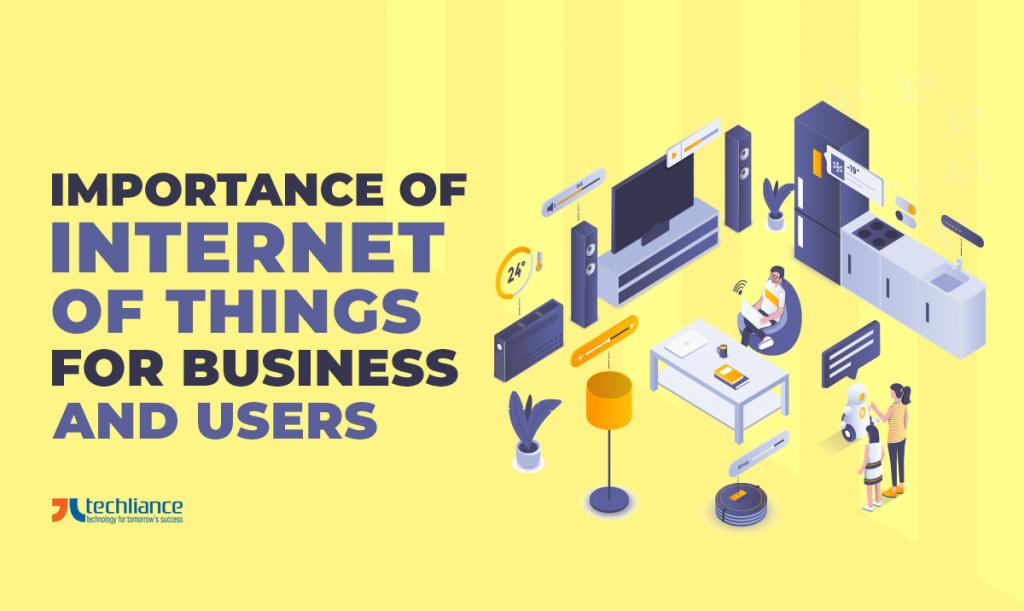
Table of contents
- What is the Internet of Things (IoT)?
- Statistics on the Internet of Things and key takeaways
- Top benefits of the Internet of Things
- Impact of the Internet of Things on businesses
- Conclusion
- FAQs about the Internet of Things (IoT)
What is the Internet of Things (IoT)?
The Internet of Things is a system where machines/devices interact through the Internet, to give users a connected experience. All these physical devices, gadgets, and machines in IoT are known as “things”. These devices are either available through networks or cloud-based platforms.
They work together in real-time to exchange valuable information. So that users get the maximum out of their tasks, routines, or assignments. How do these devices communicate? Yup, you guess it right — via the Internet.
Recollect that the Internet of Things provides legitimate insights that help in analyzing consumer behavioral patterns. In turn, this can work as a useful tool in any area of business. After all, companies are always looking for ways to expand their horizons.
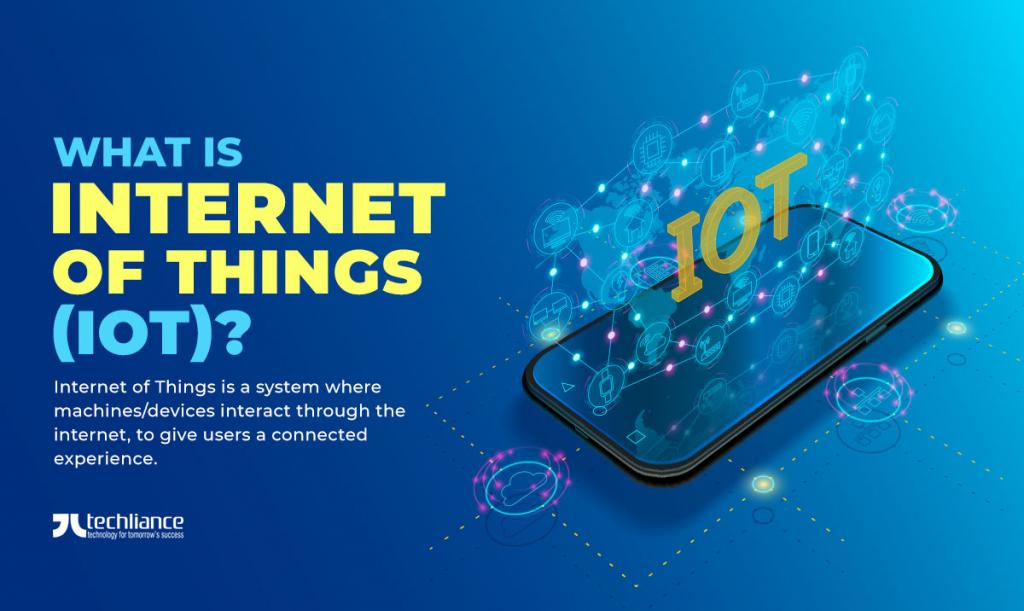
Statistics on the Internet of Things and key takeaways
The Internet of Things is set to have a powerful impression across the world. By 2025, IoT will likely have an annual economic impact of $3.9 trillion to the tune of $11.1 trillion. This top-end value means 11% of the global economy. By 2030, IoT can potentially influence the entire economy.
Globally, the number of connected IoT devices was 11.3 billion in 2020. It is predicted to cross 27.1 billion by 2025. This signifies a CAGR of 19.12% during the forecast period of 2021 to 2025. Whereas, by 2027, IoT connections will likely cross 29 billion, significantly up from 16 billion IoT endpoints in 2023.
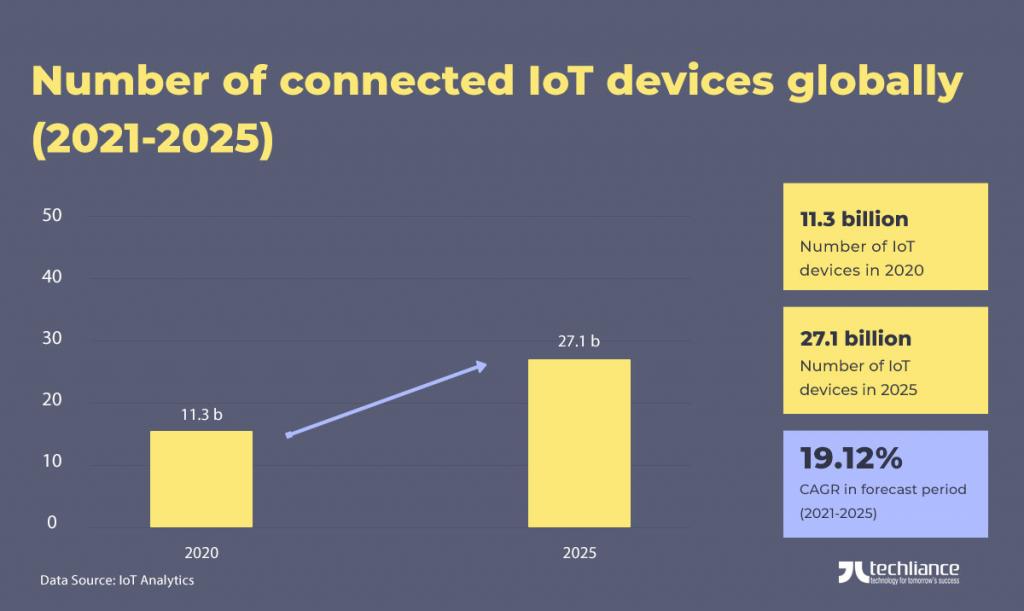
When devices started becoming smart, the conversations shifted to connectivity. The growth in IoT is massive, and we can understand it will keep skyrocketing without any stoppage. Also, IoT strengthens relevant technologies such as cloud computing, data analytics, mobile, sensors, AI, ML, and robotics.
The universal IoT market size was valued at $384.70 billion in 2021. This is estimated to reach $2465.26 billion by 2029. It denotes a CAGR of 26.4% for the forecast period of 2022 to 2029. Whereas, by 2030, this figure is likely to balloon past $3352.97 billion, up from $544.32 billion in 2022.
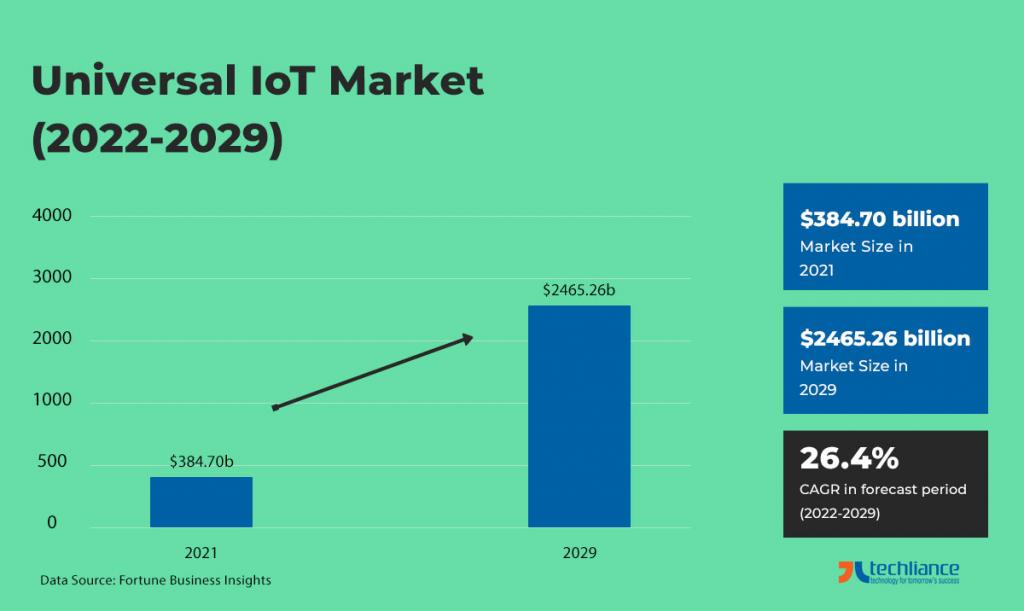
IPlytics discloses Samsung is the largest IoT patent holder having 9,550 patents in 3,850 patent families as of March 2019. Qualcomm is second with 8,545 patents across 2,252 patent families. Intel is third possessing 4,313 patents in 2,255 patent families.
In 2020, the international consumer IoT market clocked at $70.52 billion. It is forecast to hit $292.83 billion by 2030. This means a CAGR of 13.9% in the forecast period of 2021 to 2030.
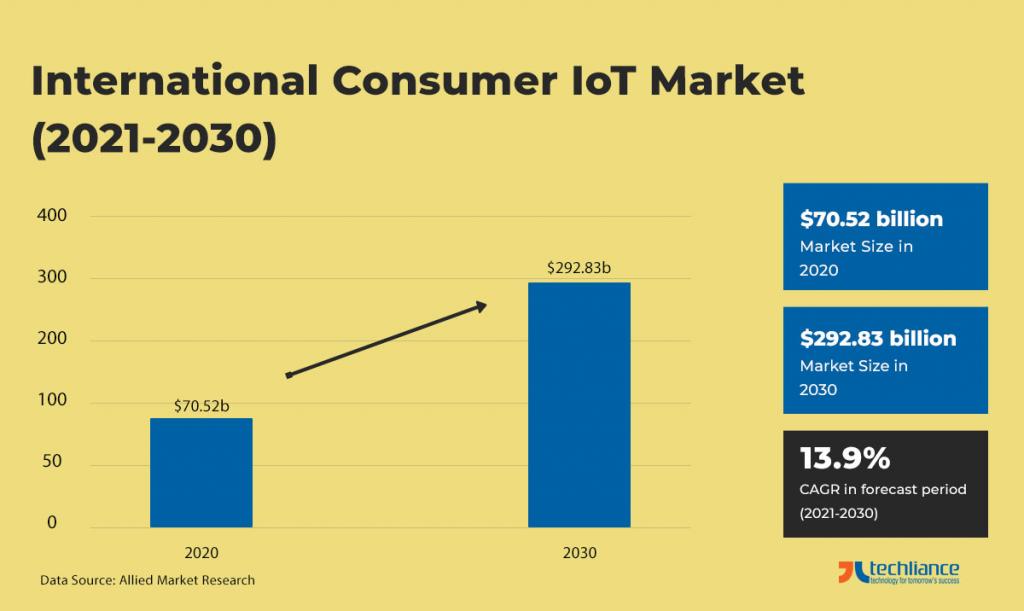
Top benefits of the Internet of Things
IoT offers various ways of increasing business prospects by providing smarter solutions with complete efficiency of operations. Also, the Internet of Things smartly works as a weapon for greater expansion for branding, retention, and customer loyalty. IoT even is useful in doing comparative analysis to understand what your next steps should be for beating your competition.
Here are the rewards that the Internet of Things presents in 2023.
- Start the day as smoothly as possible
- Complete digital transformation
- Mesh of technologies, gadgets, and services
- Higher output, lesser waste
- Technologies work together for the bigger picture
- Vigilant cybersafety
Now, we briefly look into these advantages of IoT for users.
Start the day as smoothly as possible
Imagine this scenario in your everyday life. What if you come to the point of customizing exactly your entire daily routine? You wake up to your alarm in the morning and everything is automated.
Your coffee is already brewed by the time you walk into the kitchen and toasts are perfectly toasted. You open the tap to get water at the perfect temperature as per your preference. Your car is revved up to take you to the office as you get dressed. Before you close the door, the lights are automatically off and you’re good to go.
Doesn’t the start of your day sounds perfect? That’s the power of IoT which seamlessly works in the background of your daily life. The Internet of Things ensures that all the devices intermittently work together as per your customized behavior.
Now, take IoT a notch further where you don’t have to program the devices to your whim. Devices collect enough data about your behavior to have adequate information on what you need and when you require it. This opens up a whole lot of possibilities, on account of the internet of things.

Complete digital transformation
The future of IoT is to lead the path to comprehensive business transformation. This means allowing multiple operations to follow up with proper data and analytics. So, this way users don’t even need to program their choices.
Because modern applications and devices are smart enough to interpret data and act accordingly. We already have the example of several operational IoT-connected devices globally and in the United States. For example, smartwatches to RFID-built inventory tracking chips, etc.
The concept of the Internet of Things is gaining immense popularity worldwide. Since lots of industries are adapting and incorporating IoT in their businesses. Including sectors like traffic, weather, automobiles, aviation, travel, etc. to name a few.
Mesh of technologies, gadgets, and services
A few technologies team up to make IoT a possibility. They include AI and Big Data — the two powerful forces that are constantly reshaping our world. These technologies are making our perception of reality stronger and more empowering.
Artificial intelligence is not just about robotics but embedding the technology even in devices to make them smarter. For instance, our mobile phones and digital watches can help us streamline our daily routines for higher efficiency. Because they and other IoT-enabled devices help us time our tasks.
These digital gadgets let us know the calories we consume daily. So, we can analyze the amount of exercise we need to burn these calories. Or, the number of steps we have to walk daily to stay fit.
Our digital companions can also inform us of the total time we spend on social media. Thus, we can know how much time we consume online without really doing something useful. These devices can make us aware of the last book we have read. Also, they can recommend the next book based on our previous choice, etc.
Higher output, lesser waste
The biggest promise behind IoT services is that they allow the automation of operations. So that the wait around-time between stages is minimal. IoT-powered devices work together to ensure that the output is maximum.
Businesses can use the Internet of Things in manufacturing to ensure that all devices work together in real-time. So that the output/waste of one machine automatically becomes the input for another machine. The unit is informed of any critical error before time, to decrease the risk.
This can also ensure that companies can even pre-empt any unforeseen risks. Data is transferred between devices in real time. Furthermore, the same information is analyzed to make better-informed decisions for the next step or the succeeding future.
Technologies work together for the bigger picture
Big Data and AI combine to make sure that IoT devices work together for higher individual productivity. The same concept applies to boosting business output. Imagine, that power once businesses integrate for a higher reach allowing the expansion of IoT services offered to users.
For example, tour operator companies can use the individual data of travelers. Thus, they can evaluate how users of a certain region plan their vacations during the holiday season. Moreover, they can provide the same information to airlines, hotels, and other partner businesses.
So that they can provide concessional rates to frequent flyers/tourists at those specific destinations. This is just one random idea but IoT solutions are plenty. They dictate how online consumers react to the existing products and services that are currently available in the market.
The primary advantages of IoT technology are immense both universally and locally. They include standardization, transformation, aggregation, and correlation of information. It leads to the creation of more profound technology-driven solutions.

Vigilant cybersafety
This idea has become more than having a secure password, where now security is even offered on the cloud level. Enterprises are taking great pain in providing complete security from the user level to the company level. Accordingly, they safeguard the way users access their machines, network, and data.
AI, IoT, and ML are concepts that intermittently work together in creating a seamless secure end-to-end experience for users. Even, you can program network devices to ensure only users from a certain location, machine, and time can get access. Any breach is instantly caught and you block intruders from accessing data. Businesses can maintain the log file to monitor all activities.
Likewise, web 3.0 aims for complete decentralization and enablement of blockchain. This will further enhance cybersecurity that can apply to even data levels. Eventually, hacking, money laundering, and other cyber/financial crimes will become rather impossible. Albeit if they happen; this will not be without accountability.
Impact of the Internet of Things on businesses
We are living in a busy world where the only thing that gets you ahead is your quick thinking. Instant embrace of viable technology and future innovations is necessary. That’s why understanding the crucial significance of IoT has become imperative for every company’s growth.
The Internet of Things is empowering businesses to improve their efficiency by 83%. IoT is the need of every device, be it a smartphone, a microchip, or even a hardware processor. Because they have to possess the capability of being smart and connected to enable higher productivity.
- Maximum productivity
- Understanding consumer behavior
- Eco-friendly solutions
- Damage control
- Medical healthcare
- Next-gen of services
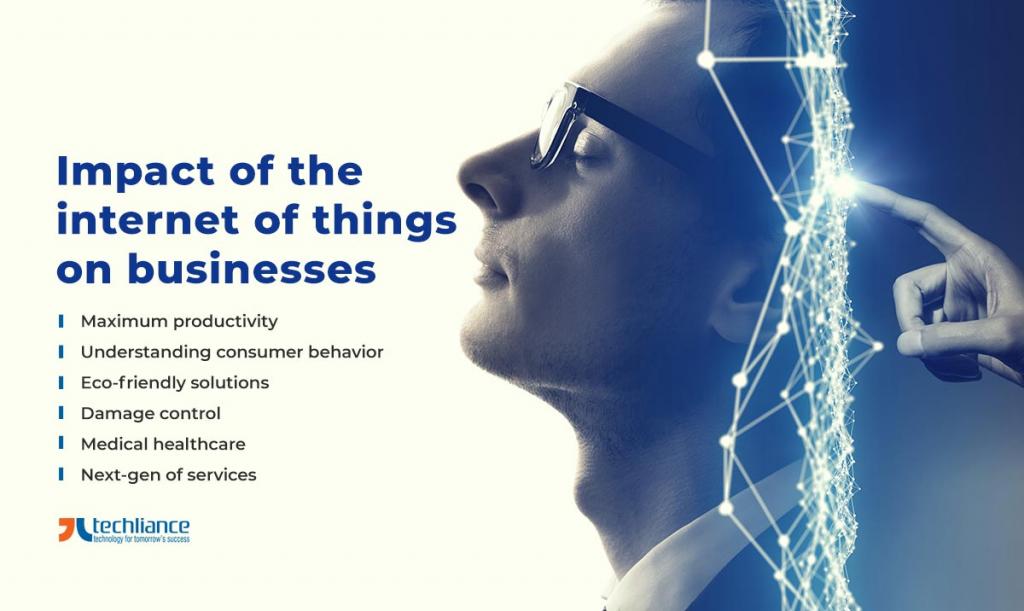
Next, we look at the areas Internet of Things affects businesses.
Maximum productivity
IoT is invariably used for mundane, routine, and operation-line processes. Because human beings possibly take longer to complete such tasks. These everyday errands usually have repetitive steps.
Imagine putting up an entire stock of items in a warehouse. You have to do this to maximize the space. It ensures that the oldest stock is at arm’s reach for stocking up the aisles, whenever the need arises.
Robots and IoT can do the needful without you having to worry about the “how” part. The Internet of Things is consistently used in manufacturing and industrial activities for assembling and managing goods. The operational processes become efficient, as programming devices function by emulating certain steps that require minimal human intervention.
Productivity even continues in automatic management with various functions such as inventory management, order tracking, fueling, and procurement. Machines are becoming smarter, as to even detect the items that need to be sold first by scanning their shelf-life. This enables businesses to put such items on sale to enhance their purchase from the stores.
Understanding consumer behavior
In our articles about IoT/IoE, we discuss technology can benefit users by availing a customized way of getting things done. This advantage is manifold because IoT helps end-users, and also allows companies to build user-centric products and services. Better yet, IoB combines the concept of things with user behavior.
We already have the customization of apps that better serve consumers. However, when other devices are also providing customizable behavior, it fully elevates the user experience. For example, what if IoT can guide fashion-conscious customers on how to dress up before leaving their houses?
Users only get advice but build their costume ensembles to their exact liking. Thanks to augmented reality (AR), they can even showcase their outfits in their 3D avatars. These are some of the ideas that will eventually transform fashion and other industries dependent on consumer behavior. Subsequently, it will make routine-like activities rather interesting and something to look forward to.
Eco-friendly solutions
The Internet of Things can work for the greater good of humanity. Especially, IoT is useful, as the concept of carbon emissions is constantly in the spotlight. So, businesses are now trying to adopt eco-friendly solutions to help in the preservation of the earth’s resources.
IoT can play a vital role in creating solutions that advise on power production and water usage. The motion sensors are capable of enabling consumers to only consume a certain amount of water without waste. Similarly, there are better ways of producing cost-effective green electricity, that help the global population along the way.
Damage control
One of the main paybacks of IoT is gathering data to collect all the viable information. Better data analytics is the foundation for enabling risk management and mitigation plans. Just imagine highly critical environments where equipment failure can become critical for human life.
Businesses can incorporate IoT to assess equipment malfunction and the condition of the workplace in terms of safety and viability. Equally, IoT can assess the risks of potential equipment breakdown and anticipate their degradation rate. Thus, companies can devise a mitigation plan to avoid the risk of equipment getting out of order in the future.
Medical healthcare
Remember that human life has the highest value. While performing various surgeries and operations, doctors need to be adept at their skills and exercise extreme caution and precision. Any wrong judgment or action can cause harm to the patient.
In serious situations, it becomes difficult to make a decision where even indecisiveness can lead to the loss of life. IoT and robotics are effective in the field of healthcare to enable high-risk surgeries. With a vast amount of data, machines (medical equipment) are better able to make critical decisions.
They are unknown to human feelings of panic, stress, or exhaustion — which enables them to operate with extreme efficiency. Also, the concept of virtual medical care is gaining popularity during the COVID-19 pandemic. Diagnostic/operative equipment has connectivity to the cloud and greatly serves in providing healthcare to patients through modern medical technology.
Next-gen of services
Technology giants are constantly investing in IoT and are coming up with great product concepts. As a result, they are even getting patents for their IoT-built device ideas. These companies are extending IoT beyond wearables and basic smart devices. Now, they are moving ahead of screen displays, TVs, washing machines, and other consumer machines that you can think of.
Currently, machines are possessing more diversity with connectivity in the cloud world. Besides, it’s all about securely exchanging data between devices, systems, and users. Ultimately, businesses have to deliver the best user experience to the customers.
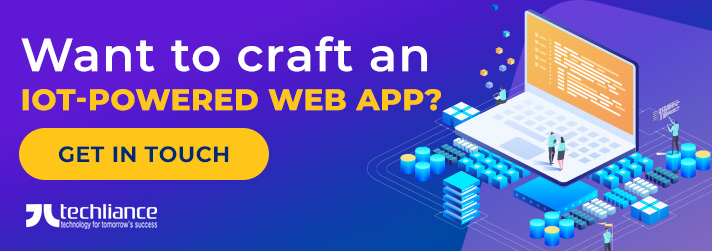
Conclusion
The Internet of Things helps you avert risks and plan what you need to do to sustain regulatory compliance. In high-risk environments, losing out on a license because you had no way of knowing about faulty equipment could mean a potential loss of revenue and reputation. By embracing IoT, you have less to worry about, and more to plan forward for higher ROI.
In today’s world, companies cannot afford to work in isolation. They can’t do much without incorporating modern technology into their businesses. Higher business insights lead to better decision-making which in turn results in higher ROI for companies.
IoT is presenting innovative ways for how we grow as users and businesses. A combination of technologies is aiding the success of the Internet of Things. Hence, we will see more great things coming from IoT in the next many years.
This chain reaction effect is the reason companies are shifting their focus on developing products and services having connectivity. Also, these solutions have the capability of integrating with the connected platforms. They can communicate with other operable devices for gaining better output.
Consequently, IoT is emerging as an integral technology in ensuring that devices work together in collaboration. They exchange valuable data which becomes useful information for making better and more informed decisions. Thus, businesses can better serve users around the world.
Are you looking for incorporating IoT software into your business? Contact Techliance today to know about all possibilities of connectivity. Come on board with a free 1-week trial.
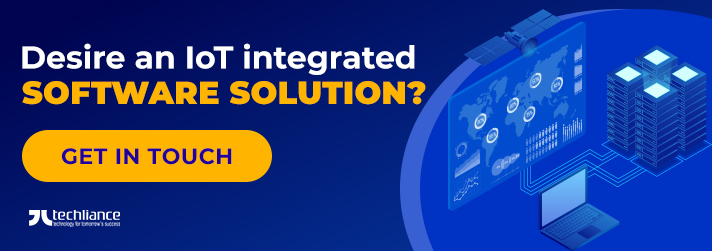
FAQs about the Internet of Things (IoT)
The following are the answers to frequently asked questions regarding the Internet of Things (IoT).
Can you describe the benefits of the Internet of Things?
A vital advantage of IoT is simpler access to data and information, even remotely from your location in real-time. The Internet of Things helps build connected, dependable, and cost-effective solutions. By using IoT, you get automated solutions having higher complexity and more security, with lesser manual input.
Which are some examples of IoT devices?
Consumer IoT devices include smart TVs, smart speakers, toys, smart consumer appliances, and wearables. Smart meters, traffic signals, commercial security systems, and smart city technologies are examples of industrial and enterprise IoT devices. They help to monitor weather, traffic, and security conditions.
What is the goal of the Internet of Things?
The aim behind the Internet of Things is to have devices that self-report in real-time. IoT systems improve efficiency by bringing important information to the surface more quickly. So, businesses don’t have to rely on non-IoT systems depending on human intervention.
Who invented IoT?
The concept of IoT has been prevalent since the 1830s. However, the term “Internet of Things” was coined by entrepreneur Kevin Ashton. He is one of the founders of the Auto-ID Center at MIT.
Kevin Ashton was part of a team that discovered how to link objects to the Internet through an RFID tag. He first used the phrase “Internet of Things” in a 1999 presentation. This term and its acronym “IoT” have stuck around ever since.
About the author




